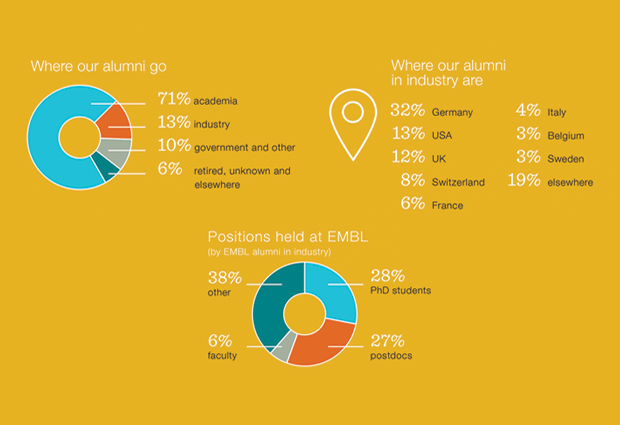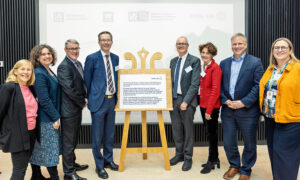
Inside industry: Part II
More than one in ten EMBL alumni successfully make the transition from academia to roles in industry, predominantly in pharma and biotech. Here, alumni in senior positions at the companies attracting the largest numbers of alumni share with us why they made the move, the challenges and highlights facing them, and EMBL’s continuing role in their career.

Cancer research connections
 Norbert Kraut
Norbert Kraut
Now: Vice-President Oncology Research, Boehringer Ingelheim, Vienna, Austria
At EMBL: 1990–1994, predoctoral fellow, Graf Group, Developmental Biology
My PhD at EMBL focused on an oncoprotein that causes leukemia. The work, which was done with Thomas Graf, exposed me to a highly creative incubator in which a series of key discoveries on oncogene activation and collaboration have been made.
I moved to industry after having received an attractive offer to build a functional genomics team at Boehringer Ingelheim in Austria, with the mission to identify novel therapeutic concepts. I knew EMBL alumni who enjoyed working there, and accepted the offer. Later, I had the opportunity to focus again on cancer research and made key contributions in the discovery and development of new cancer drugs. As the therapeutic area head, I am now responsible for the entire company’s oncology research efforts.
Boehringer Ingelheim has evolved rapidly, from having no presence in oncology to a franchise with more than 10 compounds in clinical development. We target cancer cells in various ways based on cancer genome analyses, and have significantly increased our efforts on immune cell-directed approaches. Highlights include the recent launch events for our two lung cancer drugs – Afatinib and Nintedanib. The most rewarding feeling is the personal feedback from patients whose lives have changed based on a drug discovered by our research teams.
Connections with groups in academia are crucial.
Current challenges include how we prioritise targets, develop drugs against “undruggable” oncoproteins, best restore tumour suppressor pathways, and identify highly effective drug combinations. To this end, connections with groups in academia are crucial. Work done by Thomas Graf and Hartmut Beug at EMBL in the eighties, for instance, helped in providing the foundation for Afatinib.
We are convinced that major advances and bringing forward new therapeutic concepts can only be made if academic and company investigators team up for equal partnerships. Boehringer Ingelheim is a partner of both the EMBL-EBI Industry Programme as well as the EMBL Corporate Partnership Programme. Already, we have a long and impressive list of successful collaborations which have impacted our drug discovery initiatives, and we want to further explore this with current and former EMBL scientists.
My advice to EMBLers is: Enjoy your time at EMBL, find something you are passionate about, explore new scientific territories and build up a network to help advance your scientific career.
Launching new vaccines
 John Telford
John Telford
Now: Head Microbial Molecular Biology, GlaxoSmithKline (formerly Novartis Vaccines & Diagnostics), Siena, Italy
At EMBL: 1979-1985, research technician, Pirrotta Group, Developmental Biology
I joined EMBL in 1979 in a technical position. The focus of our group was understanding gene regulation during Drosophila development. This was a fascinating period for me and made a huge difference to the way I approached biology. In fact, the work formed an important part of my PhD thesis from the University of Zurich.
I was recruited to industry by EMBL alumna Marialuisa Melli (Lulla) – attracted by the quality and projects of her group, as well as the possibility that our science could impact people’s health.
During the past thirty years at Novartis Vaccines in Italy, I have progressed from group leader to project leader and finally head of department of Microbial Molecular Biology, the focus of my group having mainly been vaccine antigen identification and characterisation. Very recently, Novartis Vaccines was taken over by GlaxoSmithKline (GSK), but our goals – the development of innovative vaccines – have not changed.
There are several EMBL alumni and three EMBO Members in our research centre and we collaborate with many more.
A highlight of the past year has been our involvement in research that led to the launch of a new vaccine against disease caused by serogroup B meningococcus, a life-threatening illness that is caused by bacteria that infect the bloodstream and lining that surrounds the brain and spinal chord. We have also contributed to the discovery of other vaccines that are now in clinical development. There are several EMBL alumni and three EMBO Members in our research centre and we collaborate with many more – industry can offer attractive careers in research to well trained scientists.
One striking memory I have of EMBL is working in the lab next door to Christiane Nüsslein-Volhard and Eric Wieschaus during the period they did the experiments that led to their Nobel Prize. Another, apart from the science, is finding the woman who has been my wife now for thirty-four years – Tatiana Baldari who is an EMBL alumna and now EMBO Member. And of course there were the parties…
Platforms for proteomics
 Gitte Neubauer
Gitte Neubauer
Now: Head of Cellzome a GSK company, Heidelberg, Germany
At EMBL: 1994-2000, predoctoral fellow, Mann group, postdoc and company foundation, Wilm group, Instrumentation
I did my PhD in proteomics at EMBL just when the field was beginning to establish itself. I learnt not only about proteomics, but also how much fun it is to work with so many excellent scientists – the diversity in skills and nationalities makes a very creative working environment!
We founded Cellzome as an EMBL spin-off company to apply proteomics technologies to drug discovery, using all aspects of what we had learnt – from proteomics to hiring the best people no matter where they come from. I moved to industry because I was attracted by the thought of making something so useful that somebody would actually pay for it. Founding Cellzome offered a fantastic combination of great science and commercial impact, plus the opportunity to build and shape an organisation from scratch. Today, Cellzome employs around 60 scientists and is fully embedded in GSK’s R&D organisation impacting drug discovery across many indications.
Be assured that cool science can also be done in industry!
Cellzome uses its (chemo-) proteomics platform to understand how drugs work on a molecular level for the discovery and development of safe and efficacious drugs. We collaborate with research groups and the excellent Core Facilities at EMBL mostly around novel technologies to study biology and drug action. We bring substantial drug discovery knowledge and associated platforms to the table, which synergise very well with those at EMBL. We regularly publish our science – on several occasions in collaboration with EMBL. Interestingly, I recently met an EMBL alumna at a different GSK site, who is now an important partner for us within GSK.
The highlights for me are the team we have at Cellzome, the science we do and its impact on developing new drugs, and what it takes to bring a new medicine to patients – the complexity of which is also the biggest challenge. My tip to young people at EMBL is to enjoy the science and the time you have to fully immerse in it – don’t leave out the parties and be assured that cool science can also be done in industry!
From molecular dynamics to drug development
 Marianne Uteng
Marianne Uteng
Now: Group Leader, Novartis, Switzerland (currently on maternity leave with an 8-week old baby)
EMBL: 2002-2008, predoctoral fellow, Surrey Group, Cell Biology and Biophysics
I did my PhD in cell biology at EMBL, using fluorescence microscopy to investigate the dynamics of a molecular motor protein in the mitotic spindle. This extensive use of microscopy and the innovations in science and technology played an important role in gaining my first position at Novartis.
I came to industry because I wanted to work at the interface of science and business, and contribute to the development of innovative, applied products that have a direct impact on human health. In this context, pharma is particularly attractive for me as it’s a highly complex business, which offers a myriad of life-long learning opportunities.
EMBL is attractive to companies like ours for its top-notch scientific expertise and training and education programmes.
The goal of Novartis is to develop products that can prevent and cure diseases, while the focus of my department is to identify and characterise drug toxicities and to establish qualitative and quantitative risks of exposure in humans. One of the great challenges is how to accelerate drug development time without increasing expenses, unethical animal use, or compromising safety and quality.
From an industry point of view, EMBL is attractive to companies like ours for its top-notch scientific expertise and training and education programmes. Novartis itself collaborates with both industry and academic partners, and offers pre- and postdoctoral programmes too. I have found this very rewarding and have hosted students in our lab, with plans for more in the future. I also welcome more opportunities to exchange knowledge and ideas with the science community.
My fondest memories of EMBL include the exceptional inter-disciplinary and friendly work atmosphere, lifelong friendships and the great parties. My advice to EMBLers is to choose between an industry or academic career path as early as possible, ideally soon after a PhD − this gives you time to learn more about the culture and dynamics of the workplace.
Inside industry: Part I > Group Leader Stefano De Renzis talks to Riccardo Cortese, former head of the Genome Biology Unit, about the Ebola vaccine candidate developed by his start-up, and his successful career in research and industry


